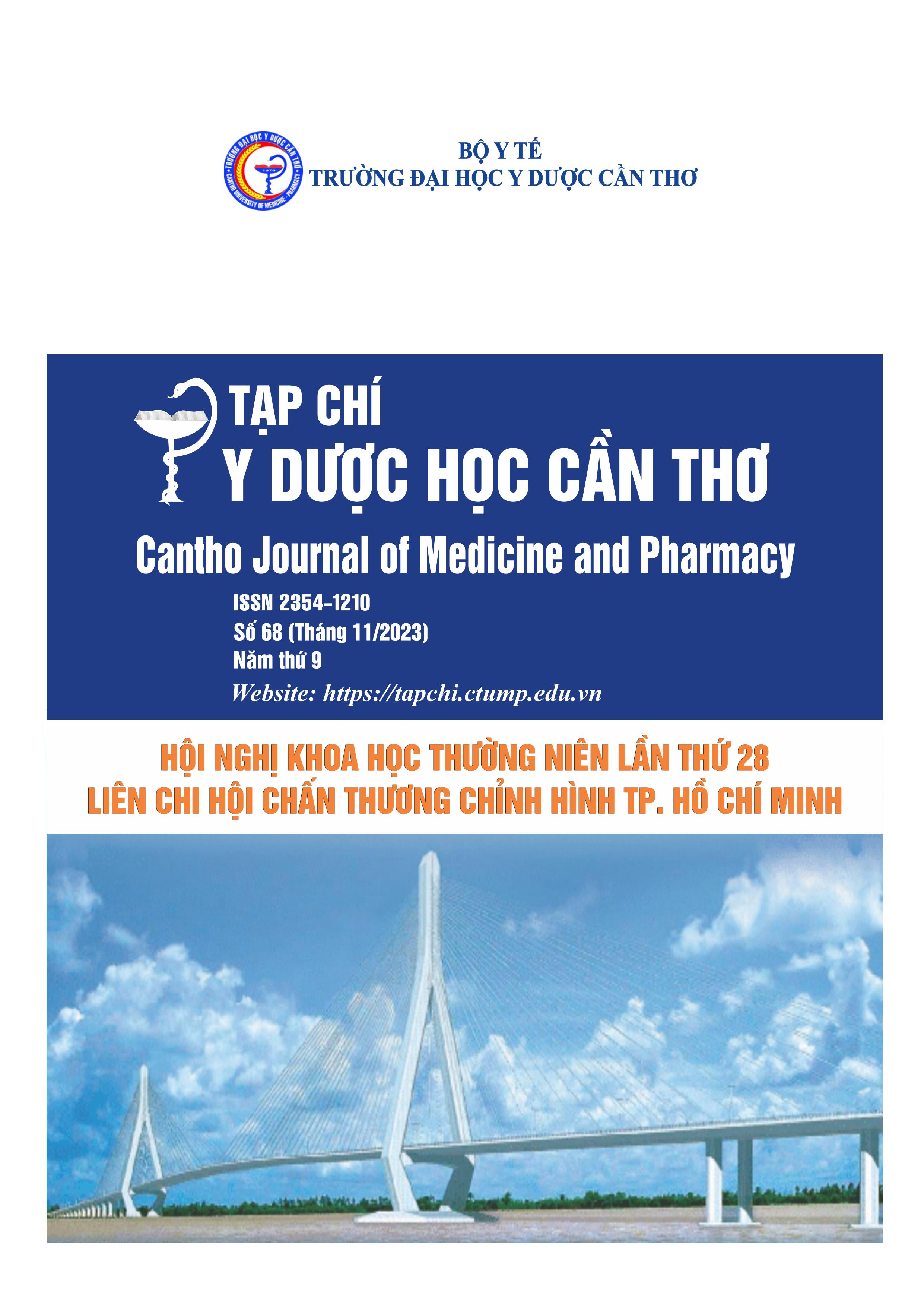ĐÁNH GIÁ KẾT QUẢ NỘI SOI ĐIỀU TRỊ TRẬT KHỚP CHÈ ĐÙI Ở TRẺ EM
Nội dung chính của bài viết
Tóm tắt
Đặt vấn đề: Mặc dù vai trò của nội soi ít được đề cập đến trong những năm gần đây nhưng nội soi giúp thám sát các tổn thương kèm theo, cắt cánh ngoài, khâu cánh trong, tránh được đường mổ dài gây sẹo xấu. Mục tiêu nghiên cứu: Đánh giá các chỉ định của nội soi trong điều trị mất vững khớp chè đùi. Đối tượng và Phương pháp nghiên cứu: Từ 2013 đến 2021, 33 bệnh nhân (35 khớp gối) từ 7-16 tuổi được chỉ định nội soi theo lưu đồ: trật lần đầu kèm mảnh gãy xương sụn, trật tái hồi, và trật thường xuyên; theo dõi từ 2-10 năm (trung bình 5,5 năm). Các phương pháp bao gồm khâu cánh trong, tái tạo dây chằng chè đùi trong, cắt cánh ngoài, kéo dài gân tứ đầu. Đánh giá tái phát, biến chứng và chức năng sau cùng theo thang điểm Kujala. Kết quả: Trong số 35 khớp gối, trật lần đầu 2 (5,7%), trật tái hồi 30 (85,7%), và trật thường xuyên 3 (8,6%); Cắt cánh ngoài 27/35 (77,1%), khâu cánh trong 23/35 (65,7%), tái tạo dây chằng chè đùi trong 12/35 (34,3%), kéo dài gân tứ đầu ở 1 khớp gối trật thường xuyên. Biến chứng đáng kể là 1 trường hợp cứng khớp gối sau cắt cánh ngoài + khâu nếp cánh trong. Tái phát ở 4/35 (11,4%) khớp gối; không liên quan đến cắt cánh ngoài (p = 0,21), khâu cánh trong hoặc tái tạo dây chằng chè đùi trong (p = 0,07); trong 23 khớp gối khâu cánh trong, tái phát liên quan đến số mối khâu (p = 0,045). Thang điểm Kujala: 88100 (trung bình 95,5). Kết luận: Phương pháp khâu nếp cánh trong vẫn cho thấy hiệu quả với tỉ lệ tái phát không khác biệt so với phương pháp tái tạo dây chằng chè đùi trong. Lưu đồ về chỉ định nội soi của nhóm nghiên cứu có thể ứng dụng rộng rãi, nhưng cần số liệu lớn hơn và theo dõi dài hơn.
Chi tiết bài viết
Từ khóa
Dây chằng chè đùi trong, cắt cánh ngoài, khâu nếp cánh trong
Tài liệu tham khảo
2. Abbasi D, May MM, Wall EJ, et al. MRI findings in adolescent patients with acute traumatic knee hemarthrosis. J Pediatr Orthop. 2012;32(8):760–764.
DOI: 10.1097/BPO.0b013e3182648d45.
3. Seeley M, Bowman KF, Walsh C, et al. Magnetic resonance imaging of acute patellar dislocation in children: patterns of injury and risk factors for recurrence. J Pediatr Orthop. 2012;32(2):145–155. DOI: 10.1097/BPO.0b013e3182471ac2.
4. Hennrikus W, Pylawka T. Patellofemoral instability in skeletally immature athletes. J Bone Joint Surg. 2013;95(2):176–183.
5. Nelitz M, Dreyhaupt J, Lippacher S. Combined trochleoplasty and medial patellofemoral ligament reconstruction for recurrent patellar dislocations in severe trochlear dysplasia. Am J Sports Med. 2013;41(5):1005–1012. DOI: 10.1177/0363546513478579.
6. D’Ambrosi, R.; Corona, K.; Capitani, P.; Coccioli, G.; Ursino, N.; Peretti, G.M. Complications and Recurrence of Patellar Instability after Medial Patellofemoral Ligament Reconstruction in Children and Adolescents: A Systematic Review. Children 2021; 8, 434. https://doi. org/10.3390/children8060434.
7. Ali S, Bhatti A. Arthroscopic proximal realignment of the patella for recurrent instability: report of a new surgical technique with 1 to 7 years of follow-up. Arthroscopy 2007; 23(3):305-311. https://doi.org/10.1016/j.arthro.2006.11.020.
8. Kepler CK, Bogner EA, Hammoud S, et al. Zone of injury of the medial patellofemoral ligament after acute patellar dislocation in children and adolescents. Am J Sports Med. 2011;39(7):1444– 1449. DOI: 10.1177/0363546510397174.
9. Hu Xu, Chunli Zhang, Guoxian Pei, Qinsheng Zhu, Yisheng Han. Arthroscopic Medial Retinacular Imbrication for the Treatment of Recurrent Patellar Instability: A Simple and AllInside Technique. ORTHOPEDICS | ORTHOSuperSite.com 2011, Vol.34, No.7, P524-529.
10. Nha KW, Kim HS, Cho ST, Bae JH, Jang KM, & Kim SG. Arthroscopy controlled medial reefing and lateral release for recurrent patellar dislocation: clinical, radiologic outcomes and complications. BMC Musculoskeletal Disorders 2021; 22:430. https://doi.org/10.1186/s12891021-04300-x.
11. Scoring of Patellofemoral Disorders Urho M. Kujala, M.D., Laura H. Jaakkola, M.D., Seppo K. Koskinen, M.D., Simo Taimela, M.D., Matti Hurme, M.D., and Olavi Nelimarkka, M.D.
Arthroscopy: The Journal of Arthroscopic and Related Surgery. 1993; 9(2):159-163. DOI: 10.1016/s0749-8063(05)80366-4
12. Lippacher S. Dejour D, Elsharkawi M, et al. Observer agreement on the Dejour trochlear dysplasia classification: a comparison of true lateral radiographs and axial magnetic resonance images. Am J Sports Med. 2012;40(4):837–843. DOI: 10.1177/0363546511433028.
13. Nam QD V, Toan N N. Role of MRI to Predict Injury Patterns of the Medial Patellofemoral Ligament in Patellofemoral Instability. Biomed J Sci &Tech Res 2(4)- 2018. BJSTR.MS.ID.000784. DOI: 10.26717/BJSTR.2018.02.000784.
14. Song JG, Kang SB, Oh SH, et al. Medial soft-tissue realignment versus MPFL reconstruction for recurrent patellar dislocation: Systematic review. Arthroscopy 2016; 32:507-516. DOI: 10.1016/j.arthro.2015.08.012.
15. Schorn D, Yang-Strathoff S, Gosheger G, Vogler T, Klingebiel S, Rickert C, Andreou D, and Liem D. Long-term outcomes after combined arthroscopic medial reefing and lateral release in patients with recurrent patellar instability – a retrospective analysis. BMC Musculoskeletal Disorders 2017; 18:277. DOI 10.1186/s12891-017-1636-8.


